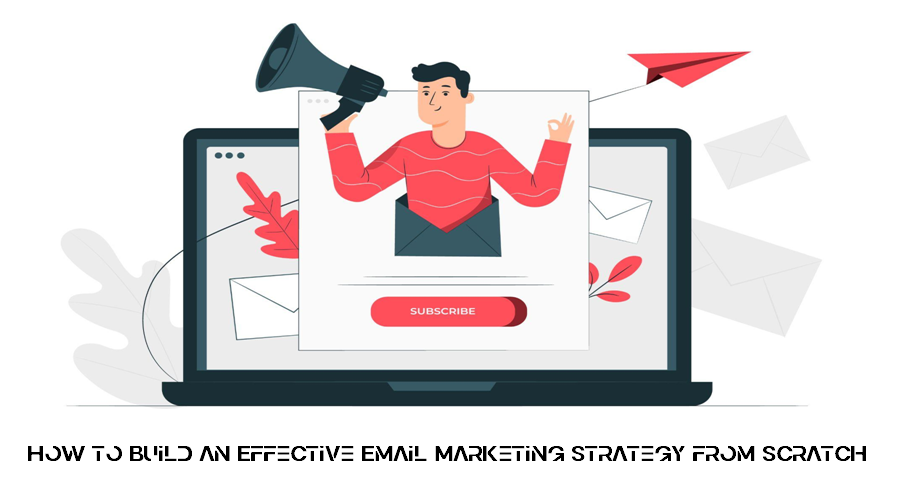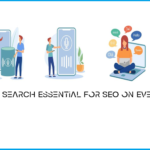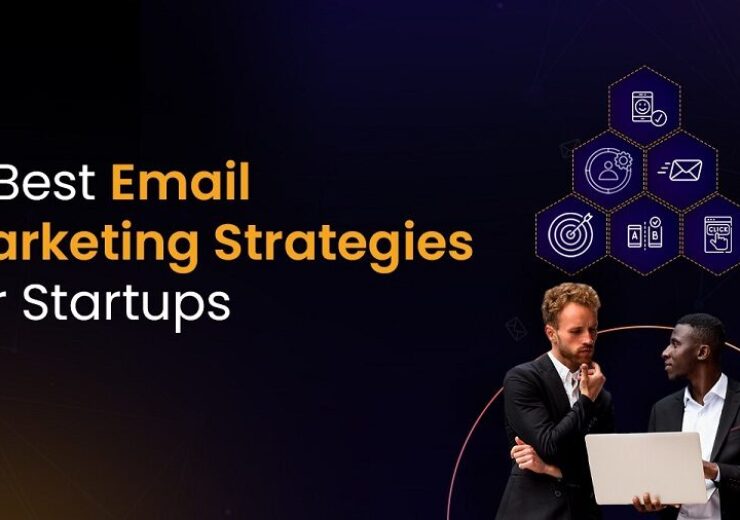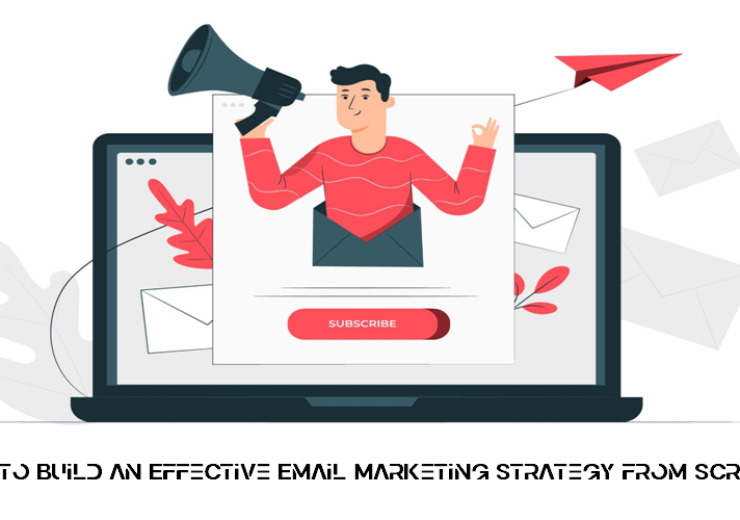How to Build an Effective Email Marketing Strategy from Scratch

Introduction
Email marketing is an indispensable tool for businesses to reach and engage customers. It remains a popular and cost-effective way of communicating with your audience.
However, building an effective email marketing strategy from scratch can be overwhelming for many businesses. With so many factors to consider – from defining your goals, targets and content to measuring performance – it’s easy to get lost in the process.
This blog will guide you in creating a successful email marketing strategy that will elevate your brand and help you achieve your business objectives. So let’s dive into email marketing and build the perfect strategy for your business needs.
Defining the Goals of Your Business
———————————-
Defining clear goals for your email marketing campaigns is crucial to creating an effective email marketing strategy.
Your email marketing goals should align with your overall business objectives, meaning they must be specific, measurable, attainable, relevant, and time-bound (SMART). By defining your goals first, you can create a roadmap for success and ensure that all other aspects of your email marketing campaign are aligned.
One goal might be to increase sales by 20% over the next quarter using targeted email campaigns. Another goal could be to grow your subscriber list by 50% within six months through social media advertising and organic traffic. Once you have defined these goals, you can begin to build out the rest of your email marketing strategy.
It’s important to note that defining clear goals isn’t just helpful for tracking progress; it also helps choose the right metrics to measure success.
Understanding Your Target Audience
———————————-
To build an effective email marketing strategy, it’s essential to understand your target audience. This means identifying the demographic groups most likely to be receptive to your messages and understanding their needs, behaviors, and preferences.
By taking the time to research your target audience and create buyer personas, you can develop content that is relevant and engaging to your subscribers. In addition, segmenting your email list based on factors such as geographic location, interests, and past purchase history can help you tailor your messages to the unique needs of each group.
Another important factor in understanding your target audience is identifying their pain points and motivations. What problems or challenges do they face that your product or service can solve? And what benefits or outcomes are they seeking from using it? By understanding your target audience, you can craft emails that resonate with your subscribers and drive engagement with your brand.
Using an email service provider
———————————-
Selecting an email service provider is crucial when crafting an effective email marketing strategy. An email service provider (ESP) is a platform that simplifies crafting and sending emails and tracking your email metrics. It ensures that your emails reach your subscribers and avoids being marked as spam. Popular ESPs include GrowMeOrganic, Mailchimp, and Campaign Monitor.
Before choosing an ESP, it’s important to identify your business goals, target audience, and budget. Once you have a clear picture of what you want, you can select an ESP that meets your needs and budget. By selecting an ESP, you’ll be well on your way to building an effective email marketing strategy.
When selecting an ESP, you should consider email automation and segmentation features. These features allow you to craft personalized emails and automate the process of email campaigns, saving you time and helping to ensure that your emails reach the right people. Additionally, many ESPs offer features such as A/B testing and analytics that allow you to track the performance of your emails.
Another important feature to consider is the ability to send cold emails. Cold emails are sent to prospects who have not yet expressed an interest in your product or service. Many ESPs have features that allow you to send cold emails, such as dedicated cold email software. This feature can be invaluable when it comes to expanding your subscriber base.
You can craft an effective email marketing strategy from scratch by selecting the right ESP. An ESP can simplify the process of crafting and sending emails and tracking your email metrics. Additionally, many ESPs offer features such as automation, A/B testing, and dedicated cold email software, which can help to expand your subscriber base. By selecting the right ESP, you can be well on your way to creating an effective email marketing strategy.
Collecting Email Subscribers
———————————-
Collecting email subscribers is an essential part of any successful email marketing strategy. A large list of subscribers lets you communicate with them directly and distribute your content, offers, and messages to a vast audience. Unfortunately, getting people to opt-in to receive your emails is not always an easy task.
Fortunately, there are a few simple ways to start collecting email subscribers from scratch. Here are some of the most effective methods for growing your list quickly and efficiently.
- Use Cold Email Software: Automated cold email software is a great option for collecting email subscribers from scratch. This software lets you quickly build custom lists from various sources, including online directories and social media sites, and then send cold emails to those contacts. This is a great way to get your message across to a large audience in a short amount of time.
- Create Website Forms: Adding opt-in forms to your website is another simple and effective way to collect email subscribers. Opt-in forms can be created using a variety of website plugins, such as WordPress and others. They are easy to customize and allow visitors to quickly and easily subscribe to your list.
- Leverage Social Media: Social media platforms offer an easy way to reach potential customers and collect email subscribers. You can use social media to share content, offers, and messages encouraging people to subscribe to your list.
- Offer Incentives: Offering discounts, coupons, or freebies is another great way to encourage people to become subscribers. This is a great way to build trust with potential customers and incentivize them to join your list.
- Use Referrals: Finally, referrals are a great way to get more people to opt-in to your list. Ask your existing subscribers to refer their friends and family to your list and reward them.
Creating Engaging Email Content
———————————-
Creating engaging email content is a crucial part of email marketing strategy. After defining your goals, understanding your target audience, and collecting email subscribers, it’s time to create content that captivates and draws in recipients.
To do this, you must know what content your audience wants to see. Personalization remains essential in creating engaging emails, so you can segment your email list based on interests or behaviors to deliver targeted content.
Short, concise, and easy-to-understand messages work best with a clear subject line and pre-header text. To make sure your content grabs the reader’s attention, use images, emojis, and other design elements to make the email visually appealing. Remember, designing an engaging email is an iterative process, so ensure you track and analyze results regularly and optimize continually.
Ensuring Deliverability and Avoiding Spam
———————————-
The success of any email marketing campaign relies heavily on the deliverability of those emails. When emails end up in the spam folder, it defeats the whole purpose of sending them in the first place. To ensure deliverability and avoid becoming labeled as spam, it’s important to follow best practices such as avoiding words that trigger spam filters, providing a clear unsubscribe option, and regularly cleaning your email list to remove inactive or invalid email addresses.
A reputable email service provider will also have tools to monitor your emails’ quality and deliverability. The Email Service Provider (ESP) follows best practices for deliverability and compliance with anti-spam laws. The ESP should also offer features such as double opt-in confirmation emails, unsubscribe links, and segmentation options for targeted messaging. By avoiding spam, you can improve the chances of your emails reaching the intended audience and achieving the desired results.
Segmenting Your Email List
———————————-
Segmenting your email list is a crucial step in your email marketing strategy. After collecting subscribers, you need to divide them into smaller groups or segments based on their interests, demographics, location, and behaviors to personalize your emails and deliver the right message to the right audience.
This will increase open rates, click-through rates, and conversion rates. To segment your email list effectively, you need to use an email service provider that allows you to create custom segments and automate the process.
You can also use lead magnets, surveys, and preference centers to gather more information about your subscribers. Segmenting your email list will help you save time and money, reduce spam complaints and unsubscribes, and improve your overall email marketing ROI.
Personalizing Your Emails
———————————-
To personalize your emails, you must first gather data about your subscribers. This could include their name, location, past purchases or behaviors, interests, etc. Once you have this data, you can begin creating tailored and personalized emails for each of your subscribers.
For example, you could include their first name in the subject line or open your email. This simple step can make a huge difference in the level of engagement you receive. Beyond that, you can use past purchase data to create hyper-targeted product recommendations. This will make the email content more relevant to the individual subscriber and increase the likelihood that they will purchase the item.
You can also use your data to segment your subscribers into different groups. This way, you can ensure you send out the most relevant information to each group. For example, if you have a group of customers who have recently purchased a product, you can create an email that speaks specifically to their needs and interests.
By taking the time to personalize your emails for each of your subscribers, you are showing them that you value their time and that you are interested in the content you send out. This can go a long way in creating a successful email marketing strategy.
If you want to make a lasting impression with your email marketing efforts, personalizing your emails should be one of the top priorities in your strategy. By gathering data about your subscribers and using it to create tailored and personalized emails, you can increase the effectiveness of your email campaigns and maximize your ROI.
Tracking and Analyzing Results
———————————-
The success of an email marketing strategy is highly dependent on tracking and analyzing the results. After defining the goals, understanding the target audience, using an email service provider, collecting subscribers, creating engaging content, ensuring deliverability, and personalizing emails, tracking and analyzing the campaign’s performance is crucial.
With tracking, it’s easy to determine how many people opened the email, clicked on the links, and the overall engagement rate. Analyzing the results helps identify areas that require improvement and what resonates with the target audience. It also helps make adjustments and ensure continuous email strategy improvement.
Utilizing email marketing tools like VerticalResponse’s A/B testing aids in analyzing the statistics for informed decision-making. In a highly competitive digital world, understanding how email campaigns perform is vital in identifying areas requiring optimization to build an effective email marketing strategy from scratch.
Continuously Improving Your Email Strategy
———————————-
After implementing your email marketing strategy, it’s important to continuously improve it. This involves analyzing your previous campaigns, identifying areas for improvement, and making the necessary changes.
One of the most effective ways to do this is by tracking and analyzing the results of each email campaign. This will give you insights into the performance of your emails, including open rates, click-through rates, and conversions. Use this data to identify what worked and didn’t and make changes accordingly.
Additionally, continue to segment your email list and personalize your emails, as these tactics have been shown to improve engagement and conversions. Finally, always experiment with strategies and techniques to see what works best for your audience. By continuously improving your email marketing strategy, you’ll be able to stay ahead of the competition and keep your subscribers engaged and interested in your business.
Conclusion
In conclusion, building an effective email marketing strategy takes time, effort, and a lot of planning. The steps outlined in this guide are essential for any successful campaign.
Personalizing your emails and segmenting your email list are key components that can help you achieve higher open and click-through rates. Tracking and analyzing your results is equally important.
By monitoring your email performance, you can identify areas of improvement and make data-driven decisions to optimize your campaigns. With a clear focus, consistent effort, and ongoing testing, you can improve your email strategy and reach your target audience more effectively.




